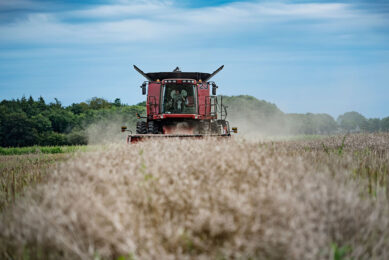Dairy production update at BSAS meeting

While milk output potential of the dairy cow has improved enormously through breeding, this has been at a cost of lowered reproduction performance. At the British Society of Animal Science meeting held in Southport recently, this issue was addressed through attention to nutritional strategies.
The first challenge in dairy nutrition and fertility research is try to reverse the issue of the dramatic decline in reproductive performance. Between 1975 and 1982, pregnancy rates to first service were around 55%. Since then they have declined and between 1995 and 1998 were 39%, according to on-farm studies carried out by Royal and co-workers in 2000. Similarly, the past 10 years has seen the number of inseminations per pregnancy increasing from 1.43 to 1.75 with the calving interval increasing from 385 to 412 days (LeRoyet al, 2006). The increased milk production potential of the modern cow also carries some direct downsides to health (metabolic disorders and poor fertility). In fact, the extent (magnitude and duration) of the post partum negative energy balance has been proposed to be the main reason for the declining reproductive performance (de Vries and Verkamp, 2000).
Energy balance indicators
The ability to predict reproductive performance with reasonable accuracy would be highly useful to dairy farmers. Various energy balance indicators, such as body condition score, can be correlated with reproductive performance and such information can be used to adjust herd management practices. In order to develop more accurate predictors of conception at first insemination, researchers Valergakis and co-workers, from Aristotle University of Thessaloniki looked at a combination of various energy balance indicators, using data from 262 first lactation Holstein dairy cows from a commercial farm in Northern Greece.
The cows were calved between 2005 and 2006. Records included conception at first artificial insemination (AI) and weekly estimates of body condition score and plasma beta-hydroxybutyrate levels. Different combinations were made and the conception rates of the resulting groups were studied. The combination of body condition score (BCS) at week 2, BCS loss between week 2 and week 6, and plasma beta-hydroxybutyrate at week 6 was the most efficient at predicting conception rate. Groups with a low BCS at week 2 and high plasma beta-hydroxybutyrate at week 6 (regardless of BCS loss) as well as cows with a high BCS at week 2, a high BCS loss and a high level of plasma beta-hydroxybutyrate at week 6 were the least fertile. In this group, only one out of 49 cows conceived. The researchers propose that combinations of energy balance indicators could be used to divide cows into three groups based on their chances to conceive at first AI (low, moderate or high probability). This can help dairy farmers to decide the length of voluntary waiting period, when to start synchronisation programmes and the price of semen used for each individual cow.
Attention to dry cow nutrition
Emphasis has traditionally been placed on post-partum nutrition in an attempt to suppress the effects of negative energy balance during early lactation. However, more recent theories recommend improving dry cow nutrition to prepare the cow for the energy demands of early lactation. According to Friggenset al(2004) priming the liver during the dry period would allow the cow to better deal with metabolic processes in the post partum period. Therefore, researchers Law and co-workers from the Agri-Food and Biosciences Institute in Belfast, UK, looked at offering dairy cows different energy levels pre and post calving in an attempt to modify energy balance pre and post calving.
Forty Holstein heifers and forty Holstein cows (mean parity 3.2) were allocated to one of four treatments, based on a 2X2 factorial design: high or low energy density diet pre and post calving. The four treatments were ad lib high energy, ad lib low energy, restricted high energy, restricted low energy. Results are given in Table 1. A restricted low energy pre-calving diet significantly reduced body reserve mobilisation post-calving (indicated by plasma NEFA concentrations) resulting in a more rapid return to positive energy status. These findings concur with Grumet al(1996) who suggested that loss of body condition during the dry period reduced body reserve mobilisation post-calving, therefore maintaining liver function.
Heifer replacements are key to profits
Rearing heifer replacements that reach first calving at an age and body weight to achieve their full lifetime potential, is a key factor in dairy enterprises. Rate of growth during the rearing period has a direct effect on age at first calving (Heindrichs, 1993). Researchers Brickell and Wathes from the Royal Veterinary College in London carried out a survey of UK dairy farms in order to look at the effect of growth rate during the first six months of life on age at first calving, and subsequent fertility and milk production during first lactation of Holstein-Friesian heifers. An increased average daily gain during the first six months of life significantly reduced the age at first calving. After first calving a larger proportion of these animals were pregnant by 200 days. Increasing average daily gain, often through high planes of nutrition, will increase rearing costs, likewise a low ADG will lengthen the non-productive period. Therefore they suggest rearing heifers at a moderate growth rate of between 0.6 and 0.8 kg/day, during the first 6 months of life. The workers propose that more effort should be made within the industry to ensure all heifers within a cohort reach this target.
Options for healthy milk and efficiency
At the BSAS meeting, attention was also given to the nutritional aspects of dairy products and how animal nutrition can be used in this. Milk contains unsaturated fats both monounsaturated (MUFA) and polyunsaturated (PUFA) which have been reported to benefit human health (Givens and Shingfield, 2004). PUFA can be further categorised as omega-3 and omega-6 fatty acids. The main omega-3 fatty acid in milk is alpha-linoleic acid and the main omega-6 fatty acid in milk is linoleic acid (LA) both of which are important, since they cannot be synthesised in mammals and therefore have to be supplied from dietary origins (Ruxton et al, 2005). Other beneficial fatty acids in milk include cis-9, trans -11 conjugated linoleic acid (c9t11 CLA) and trans -11 C 18:1 (VA), a precursor of CLA.
Management and Fatty acid profile
A study by Stergiadis and co-workers at the University of Newcastle looked at differences in fatty acid composition between organic and conventional commercial whole milk during winter and summer seasons. 36 different sources of commercial whole milk, characterised by brand and management system, were collected from retail outlets in the North East of England. 11 brands were certified and labelled as organic. Milk purchase was carried out over two years on four sampling dates: two during winter and two during summer.
Results showed that organic milk contained significantly higher concentrations of all beneficial fatty acids compared to conventional milk (Table 2). Summer milk was significantly higher in VA, c9 t11 CLA and alpha-linoleic acid (alpha LN) but lower in linoleic acid than winter milk. Table 3 shows that organic management significantly increased poly unsaturated fatty acid and had no effect on SFA and MUFA concentration of milk. Summer milk had significantly higher concentrations of PUFA and MUFA and lower SFA content than winter milk.
The authors concluded that milk produced either under organic management or during August is likely to have higher concentrations of specific unsaturated fatty acids shown to be beneficial for human health compared with milk produced under conventional management or during January.
Replacing saturates with unsaturates
Alteration of the fatty acid composition of milk through targeted manipulation of dairy cow diets is currently a topic of interest. But while it seems obvious that replacing saturated fatty acids in milk with MUFA would reduce the risk factors for cardiovascular disease, caution should be taken in this approach. For example, the inclusion of rapeseed in dairy cow diets simultaneously reduces milk saturated fatty acids and increase cis-MUFAS, but also increases milk trans MUFA. Trans fatty acids are undesirable because they are a potential risk factor for cardiovascular disease. Researchers Kleim, Humphries and Given from the University of Reading have therefore looked at a new variety of rapeseed with a higher oleic acid content, and therefore presumably less potential for increasing milk trans-fatty acids than conventional rapeseed. Both varieties were compared with a control diet.
Normal versus high oleic acid rapeseed
In the experiment, seven early lactation multiparous Holstein-Friesian cows were randomly allocated to one of seven total mixed ration diets (50:50 forage: concentrate) for 5 x 28 day periods, in an almost Balanced Incomplete Block Design. The forage proportion of the diets contained both maize and grass silages (3:1).
A control diet contained 41 g/kg dry matter of calcium salts of palm oil fatty acids, and six treatment diets contained one of two different rapeseeds (normal oleic acid content, varieties and high oleic acid content, milled with wheat; 750 kg wheat to 1000 kg whole rapeseed) and included at three inclusion levels so that diets provided approximate intakes of 750, 1000 and 1250 g/cow/day rapeseed oil. Oleic acid content of the high oleic acid rapeseed/wheat mix was 70 g/100g total fatty acids compared with the normal oleic acid rapeseed/wheat mix which was 58g/ 100g total fatty acids.
Use of high oleic acid rapeseed
The results are given in Tables 4 and 5. Both rapeseed supplements were effective at lowering milk SFA and increasing cis-MUFA linearly.
The high oleic acid rapeseed was more effective at doing this, probably due to the higher oleic acid content. However, despite having a lower polyunsaturated fatty acid content, the high oleic acid rapeseed diets caused a similar increase in milk trans-MUFA compared to the normal oleic acid rapeseed, suggesting that the variation in fatty acid profile between the two rapeseeds was insufficient to influence ruminal production of trans-MUFA. A rapeseed with a higher oleic acid content (and therefore lower PUFA content) or perhaps a higher inclusion level, may have had more influence.
Breed effects
Breed effects on the fatty acid composition of milk have previously been reported (Kelsey et al, 2003). However, most work to date has been conducted under high input total mixed ration based systems. New work by Palladinoet alfrom University College Dublin in collaboration with Teagasc, Ireland, shows that under grazing conditions consisting predominantly of perennial ryegrass, Holstein dairy cows produce more milk with a higher content of CLA when compared with Jersey cows. They propose that this may be due to a higher activity of the delta 9 desaturase enzyme in the mammary gland of Holstein cows.
Efficient grazing systems
Turning attention to the efficiency of milk production systems, researchers Sinclair and McAleer from Harper Adams University in Shropshire have looked at the effects of grazing period and supplemental straw on milk output of autumn calving dairy cows.
They found that allowing access to grazing for two hours per day during Spring and including 1kg per day of chopped straw in the ration led to a total mixed ration saving of around 5 kg DM per cow per day, without any reduction in milk production. There was no effect of access to grazing or straw allocation on milk yield, composition or component yield, and no effect of treatment on liveweight or body condition score change.
Continuous efficiency improvements
An overview of the type of efficiency improvements that can be targeted was given by Dr Nigel Scollan from Aberystwyth University. Ruminant production in the UK is largely dependent on grasslands; approximately 52% of UK land is (improved) grassland and rough grazing. Herbage production from improved grasslands can be over five times higher than that of indigenous swards (Davieset al,1984) and these pastures account for the majority of ruminant (meat and milk) production. They are also amenable to manipulation through the choice of species, variety and mixture of forages sown. Efficiency of production can be influenced at the levels of both the plant and the animal and by the nutrition and genetics of both. For animals at pasture the most effective options involve the appropriate choice of grazing material. Improving dry matter digestibility has been, and remains a key plant breeding objective to increase the nutritive value of forage crops.
Based on information presented at the British Society of Animal Science March 30th– April 1st in Southport, UK. Thanks to the organisers and the authors for providing the information.












